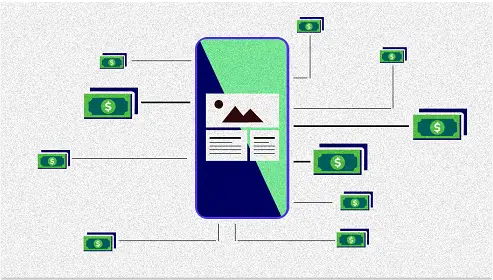
Boosting Your Revenue with Mobile Enterprise Apps
Allowing your employees to use their mobile devices in a BYOD environment can greatly improve efficiency. When combined with simple and powerful enterprise apps, an employee’s device can become a powerful tool; improving not only worker efficiency, but helping your business in many other ways as well. In this article, we will be focusing on how proper use of mobile enterprise apps can result in a measurable increase in revenue, or at least a savings in costs.
Increasing Sales and Customer Satisfaction
Some of the responses on this graph may be due to the fact that some sources will call any app created by a business as an “enterprise app”, though the term is more often used to imply “inwardly-facing” applications that are used by company employees (including subcontractors) as opposed to “outwardly-facing” apps that are mainly used by customers.
Nevertheless, there are ways in which a true enterprise app can boost sales and customer satisfaction numbers. Consider the example of a salesperson that is able to access up-to-date data via his mobile device immediately prior to a meeting or presentation. The aid provided by a well-designed mobile app can significantly add to the salesperson’s preparation and confidence, thus resulting in a better interaction with potential clients. By empowering your employees, an enterprise app can, in fact, lead to a marked increase in sales and revenue.
Customer satisfaction is another factor that, at first glance, seems more likely to increase with a commercial or retail app as opposed to an internal one. A recent enterprise app that we developed for the construction industry, however, illustrates that this is often not the only way to improve customer interactions. A mobile app can instantly update field personnel on issues that a client is facing; allowing for these problems to be addressed with greater speed and accuracy, as well as insuring that no issues are left unresolved. Use of this product has indeed helped customer satisfaction by increasing the productivity of the employees that are directly interacting with clients, and by making those clients feel that their concerns are being immediately acknowledged and addressed.
Better Communication and Collaboration
Communication is another factor that can be greatly enhanced using enterprise apps. Though it may be more than sufficient to point to the productivity boost that proper and timely inter-office communication provides, there are other scenarios that provide a much more concrete example of how enterprise apps can cut down on a company’s costs. One such app that we helped to develop allowed a local organization to save a huge amount in printing costs, as all their inter-office memos and newsletters were being printed at an approximate cost of $30,000 per document (as they had over 100,000 members), and as they were producing multiple memos and newsletters per year. Although the organization in question still prints some material to distribute to those members that do not have access to the app, the cost savings are enormous.
Portability and Flexibility
The majority of enterprise apps that we have helped create are largely centered around their use “in the field”. Digital punchlist software for residential and commercial construction companies, welding procedure and inspection apps for pipeline companies (mostly involved in oil & gas and other energy sectors), and various environmental and infrastructure tools for government entities. Many of these apps allow for “offline” use: allowing field personnel to access data and complete tasks while in areas of limited connectivity.
The very nature of mobile devices can also greatly enhance productivity through these apps when in the field. Paper reports can be very limited in the amount of information that can be documented, and older electronic (i.e.: desktop) solutions require the worker to retain data in another form (or simply try to memorize it) before it can be properly recorded. This often results in limited, and sometimes inaccurate, data. With mobile enterprise apps, information is not only recorded immediately, allowing for greater accuracy and detail, but can also be readily enhanced by the use of photos (or videos) and geographical locations; ensuring that the next employee to make use of said data (either in the office or in the field) has a much clearer idea of the issue or report that has been documented.
Having this data on a portable device not only enhances productivity (especially in a BYOD environment, where the user is intimately familiar with the device) but allows employees to make faster and more accurate decisions. This further empowers workers to be able to take action without having to reach out to superiors that would (in other scenarios) have access to a larger pool of data; creating a positive experience not only for the clients that they are interacting with, but for employees as well. This, of course, also directly results in the reduction of costs to the company: saving not only in paper costs, but in overall man-hours, and (in this example of portable data being used in the field) to travel costs and time as well.
Statistics on Employee Productivity
Though already mentioned in most of the examples above, some numbers can help illustrate just how much revenue and/or savings can be generated by increasing productivity among your team. Though some of the figures presented here (and in the infographic below) are a couple of years out of date, they still do a good job of showing the overall benefits of how beneficial enterprise apps can be in increasing worker productivity, and how that can translate into a monetary gain.
I will let the infographic provide most of the data, but another survey I found suggested that “enterprise mobility” (or the use of mobile enterprise apps) results in an additional 240 hours (or six weeks, at 40 hours a week) of work per employee per year. This results in an average savings of $5,114 (again, per employee per year).
It Has Never Been Easier to Create Your Enterprise App
Over time, as many similar features and technologies (such as Content Management Systems) are required by businesses of varying types and sizes, we have been able to largely streamline our development process (through the use of frameworks and other tools) to create robust and easy-to-use enterprise apps with a minimum amount of tweaking and troubleshooting; allowing for a much shorter timeframe from concept to deployment.

